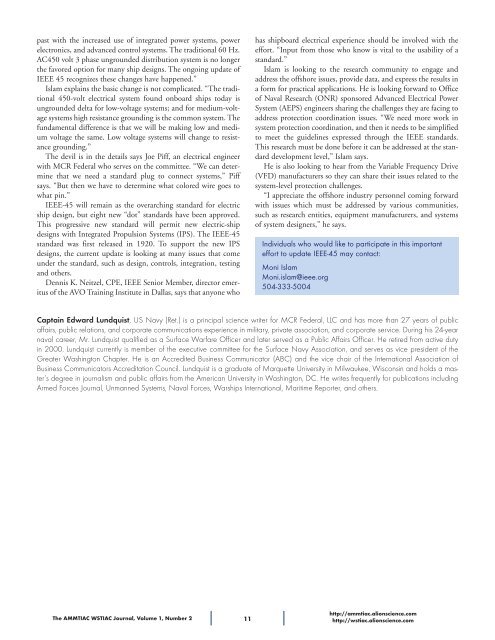AMMTIAC-WSTIAC Journal, Vol. 1, No. 2 - Advanced Materials ...
AMMTIAC-WSTIAC Journal, Vol. 1, No. 2 - Advanced Materials ...
AMMTIAC-WSTIAC Journal, Vol. 1, No. 2 - Advanced Materials ...
- No tags were found...
You also want an ePaper? Increase the reach of your titles
YUMPU automatically turns print PDFs into web optimized ePapers that Google loves.
past with the increased use of integrated power systems, powerelectronics, and advanced control systems. The traditional 60 Hz.AC450 volt 3 phase ungrounded distribution system is no longerthe favored option for many ship designs. The ongoing update ofIEEE 45 recognizes these changes have happened.”Islam explains the basic change is not complicated. “The traditional450-volt electrical system found onboard ships today isungrounded delta for low-voltage systems; and for medium-voltagesystems high resistance grounding is the common system. Thefundamental difference is that we will be making low and mediumvoltage the same. Low voltage systems will change to resistancegrounding.”The devil is in the details says Joe Piff, an electrical engineerwith MCR Federal who serves on the committee. “We can determinethat we need a standard plug to connect systems,” Piffsays. “But then we have to determine what colored wire goes towhat pin.”IEEE-45 will remain as the overarching standard for electricship design, but eight new “dot” standards have been approved.This progressive new standard will permit new electric-shipdesigns with Integrated Propulsion Systems (IPS). The IEEE-45standard was first released in 1920. To support the new IPSdesigns, the current update is looking at many issues that comeunder the standard, such as design, controls, integration, testingand others.Dennis K. Neitzel, CPE, IEEE Senior Member, director emeritusof the AVO Training Institute in Dallas, says that anyone whohas shipboard electrical experience should be involved with theeffort. “Input from those who know is vital to the usability of astandard.”Islam is looking to the research community to engage andaddress the offshore issues, provide data, and express the results ina form for practical applications. He is looking forward to Officeof Naval Research (ONR) sponsored <strong>Advanced</strong> Electrical PowerSystem (AEPS) engineers sharing the challenges they are facing toaddress protection coordination issues. “We need more work insystem protection coordination, and then it needs to be simplifiedto meet the guidelines expressed through the IEEE standards.This research must be done before it can be addressed at the standarddevelopment level,” Islam says.He is also looking to hear from the Variable Frequency Drive(VFD) manufacturers so they can share their issues related to thesystem-level protection challenges.“I appreciate the offshore industry personnel coming forwardwith issues which must be addressed by various communities,such as research entities, equipment manufacturers, and systemsof system designers,” he says.Individuals who would like to participate in this importanteffort to update IEEE-45 may contact:Moni IslamMoni.islam@ieee.org504-333-5004Captain Edward Lundquist, US Navy (Ret.) is a principal science writer for MCR Federal, LLC and has more than 27 years of publicaffairs, public relations, and corporate communications experience in military, private association, and corporate service. During his 24-yearnaval career, Mr. Lundquist qualified as a Surface Warfare Officer and later served as a Public Affairs Officer. He retired from active dutyin 2000. Lundquist currently is member of the executive committee for the Surface Navy Association, and serves as vice president of theGreater Washington Chapter. He is an Accredited Business Communicator (ABC) and the vice chair of the International Association ofBusiness Communicators Accreditation Council. Lundquist is a graduate of Marquette University in Milwaukee, Wisconsin and holds a master’sdegree in journalism and public affairs from the American University in Washington, DC. He writes frequently for publications includingArmed Forces <strong>Journal</strong>, Unmanned Systems, Naval Forces, Warships International, Maritime Reporter, and others.The <strong>AMMTIAC</strong> <strong>WSTIAC</strong> <strong>Journal</strong>, <strong>Vol</strong>ume 1, Number 2 11http://ammtiac.alionscience.comhttp://wstiac.alionscience.com
















